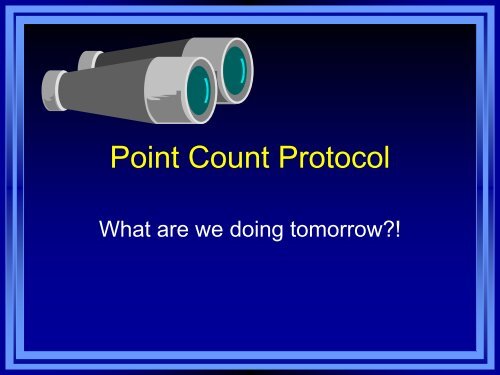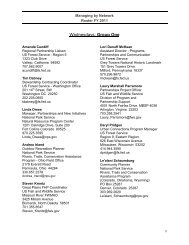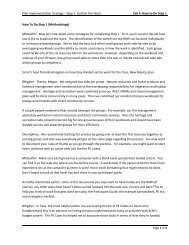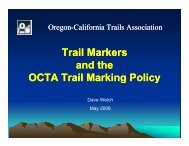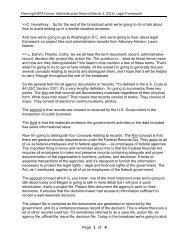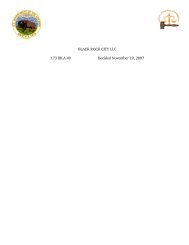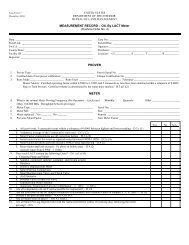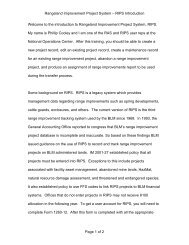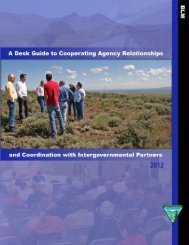Point Count Protocol--Powerpoint
Point Count Protocol--Powerpoint
Point Count Protocol--Powerpoint
- No tags were found...
Create successful ePaper yourself
Turn your PDF publications into a flip-book with our unique Google optimized e-Paper software.
<strong>Point</strong> <strong>Count</strong> <strong>Protocol</strong>What are we doing tomorrow?!
Why <strong>Point</strong> <strong>Count</strong>s?• Cost-effective method of estimating therelative abundance of birds• Least subjective method• Most reproducible method
General Methodology• A series of points are established in anarea.• Observer visits points during optimaltimes to detect birds of interest.• At each point observer records all birdsdetected (sight & sound), withinspecified time and distance.
Detailed Methodology• Spacing of <strong>Point</strong>s– Place far enough apart to avoid countingbirds previously recorded.– Standards recommend 250 meters.– In more open habitats, 500 meters.
More Details• Marking <strong>Point</strong>s– Mark permanently with immovable object(post, metal tag on tree)– Locate on detailed map– use GPS
More Details• Location of <strong>Point</strong>s– For an entire management unit, placepoints systematically.– For specific habitats, stratify area byhabitat, and assign points systematically.
More Details• Timing of Visits– Sunrise to about 4 hours after sunrise.– For breeding birds, best time is fromterritory formation to early incubation. Thisis June in many areas, probably March-April in the desert southwest.
More Details• Length of <strong>Count</strong>– 5 minutes recommended. Can do longercounts (up to 10 minutes) if travel betweenpoint count stations is great. Track countsfrom 0-3 minutes for comparison to otherprograms such as BBS.– The longer the count period, the morelikely to double count individuals.
More Details• <strong>Count</strong>ing Radius– Fixed radius recommended. Record birdsin 0-25 m, 25-50 m, and >50m. Can varyby habitat, with larger radii in more openhabitats.
What to Record:• Species - use 4-letter codes• Distance interval or exact distance• Age/sex• Treat flyovers separately
Pros & Cons• Pros:– Predominant technique used in NorthAmerica– Recommended by PIF– More sample points per effort– May detect species missed by othermethods
Pros & Cons• Cons:– May flush birds as approach point– Not as efficient as transects in terms ofdetections per effort– Not useful for secretive, quiet species– Gives no information on productivity– Does not work equally well in all seasons
Variable Circular Plot (<strong>Point</strong> <strong>Count</strong>) Field SheetStateStation Unit Compartment Road Route # <strong>Point</strong> # Date Observer TimeTemp C Wind Sky Slope Aspect Habitat Habitat TypeHabitat QualityNorth25m 50m 100mFemale ObservedNOCAN-S Coordinate:______________ E-W Coordinate:______________ Zone*:_______(N-S=Latitude; E-W=Longitude) *Zone = 0 for lat-long (geographic); else enter a UTM Zone.Flyovers:________________________________________________________________Comments:______________________________________________________________Male ObservedPair Together,assumed matedObserved,sex unknownNOCANOCANOCANOCANOCA0-3 minutes4-5 minutes6-10 minutes
Variable Circular Plot (<strong>Point</strong> <strong>Count</strong>) Summary SheetStateStation Unit Compartment Road Route # <strong>Point</strong> # Date Observer TimeTemp C Wind Sky Slope Aspect Habitat Habitat TypeHabitat QualitySpecies Alpha Code 0 – 25 m 25 –50 m 50 – 100 m >100 m0-3 min 4-5 min 6-10 min 0-3 min 4-5 min 6-10 min 0-3 min 4-5 min 6-10 min 0-3 min 4-5 min 6-10 minFlyovers:_______________________________________________________________________________Data Compiler:__________________________Comments:___________________________________________________________________________________________________________________________________________________________________-- LMVJV March 2003 --


